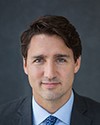Mr. Speaker, I am honoured to speak to this bill, which I think is very important because I believe that citizenship is the foundation of Canadian society.
My riding in the greater Toronto area has more than 200,000 constituents, while other ridings have fewer than 100,000. That is not fair and it is a sort of insult to Canadian citizens in some areas of the country.
This is one of the most important bills the House has considered in the last 10 years or so. The reason for this is I believe the most fundamental foundation for Canadian society is Canadian citizenship. I believe strongly that all Canadian citizens, regardless of their ancestry, religion, creed or race, should be treated equally in our country. However, when we have a situation where in one part of the country there are over 200,000 citizens in a riding and in another part of the country there are fewer than 100,000 citizens in a riding, that flies against the very basic Canadian and constitutional principle that all Canadians are equal and they should all have an equal say in who governs the country.
In fact, I would argue that it is the basis of Confederation. It was the long-held conviction of the first leader of the Liberal Party of Canada, George Brown. His statue stands behind the Parliament Buildings overlooking the Ottawa River. He was leader from 1857 and post-Confederation until 1873. He fought for that principle, both in the united Province of Canada before Confederation and subsequently in Confederation itself. It was in part because of that leader's efforts that Confederation was forged.
However, today we have come a long way from that constitutional and founding principle of the country. The gap between how many voters an MP represents in rapidly growing provinces like British Columbia, Alberta and Ontario and that of an MP who represents a riding in one of the seven other provinces has never been as large as it is today. Never has the gap been so large, since 1867.
Under the current formula, the seats that have been distributed in this chamber, according to the provincial divisions, have reached the point where the average MP in Ontario, B.C. and Alberta represents almost 30,000 more Canadians than MPs in the seven other provinces. This has undermined the very principle on which this chamber is based, representation by population. It flies in the face of the very basic constitutional principle that Canadian citizenship is the basis of our society, that all Canadian citizens should be treated equally and that all Canadian citizens should have a fair and equal say in who represents them in this chamber.
In the 1991 Supreme Court ruling on the proposed changes to the electoral boundaries for the provincial division in the House of Saskatchewan, the court stated:
A system which dilutes one citizen's vote unduly as compared with another citizen's vote runs the risk of providing inadequate representation to the citizen whose vote is diluted....The result will be uneven and unfair representation.
Clearly, we have a problem that needs to be dealt with before the next election and a problem with which Bill C-20, now at third reading, will deal.
We, as the government, have been debating this issue for over four years. The first iteration of a bill to re-apportion the seats in the House was introduced on November 14, 2007. It was Bill C-22, An Act to amend the Constitution Act, 1867 (Democratic representation). Some two years ago, a second iteration of the bill was introduced as Bill C-12, An Act to amend the Constitution Act, 1867 (Democratic representation). It was introduced on April 1, 2010.
Therefore, this is the third iteration of the bill with which we have now been presented. We have gone through extensive consultations with stakeholders, with various provinces, with members of Parliament in the debates that we have held in this chamber. It is now time that we deal with this issue, especially considering that the electoral boundaries commissions for the various provinces will be setting up shortly and will be undertaking a review of the proposed boundaries that would be used in the 2015 election.
As I said, this has been a long-standing commitment of the government. The bill also meets the government's commitment with three principles that we outlined in our last election platform, three principles that we had long held to. They are as follows.
First, we need to ensure that the rapidly growing regions of the country, particularly in areas like Calgary and Edmonton, greater Vancouver, the Lower Mainland, and the greater Toronto area, are properly, fairly and equitably represented in the House. That is why the bill would give 15 new seats to Ontario, 6 new seats to Alberta and 6 new seats to British Columbia.
We also committed to a second principle that would ensure that no slower-growing region of the country would lose seats. We have ensured that the provinces whose populations are not growing do not lose their number of seats in each provincial division in the House.
The third principle we committed to was to ensure that the provincial division of Quebec in the House would not under-represented. That is why in Bill C-20 would add three new seats for the provincial division of Quebec to ensure that its representation levels in the House would not fall below average.
The bill upholds those three principles and meets the fundamental requirement that the House be representative of the population of the country.
There have been some criticisms of the bill. I would like to talk about some of the criticisms that the official opposition has levelled at the bill. It is proposing that we fix the number of seats in the House for the provincial division of Quebec at the percentage it had in November of 2006. I cannot strongly disagree enough with that principle.
The first point I want to make to rebut the argument that the provincial division of Quebec should have a certain number of seats is that these seats do not belong to any province. The seats are federal seats. We consult with the provinces because we want their input, but at the end of the day, the seats are accorded to provincial division for administrative purposes. There is no reason why these seats belong to a particular province. They are simply provincial divisions for administrative purposes. The idea that any one provincial administrative division in the House should have a certain fixed percentage of the seats for time eternal flies against the very basic fact of Confederation, which is that this chamber needs to be representative of its population.
We used to have a guaranteed number of seats for a provincial division, or for an administrative division on Parliament Hill. That was for the United Province of Canada. After the rebellions in Lower and Upper Canada in the 1830s, came Lord Durham's report. Out of Lord Durham's report was the fundamental recommendation, acted upon by the authorities, that the Act of Union of 1840 would be implemented.
Out of the act of 1840, we merged the colony of Lower Canada, now Quebec, and the colony of Upper Canada, now Ontario, into the United Province of Canada. That act took effect in 1841. We had a single legislature and the capital bounced around from Kingston to Montreal, where it was burned, and later on to Ottawa. This site was selected as the provincial capital for the provincial legislature.
In that provincial legislature in the unitary state of Canada, as we did not have a federal state at the time, was the guarantee of 42 seats for Canada West, which is now part of the province of Ontario, and 42 seats for Canada East, which is part of the province of Quebec. It was a unitary state and because of the divisions between the francophones and anglophones, it was felt best to guarantee in the unitary state half of the seats for one administrative region and half for the other administrative region.
That operated for the better part of 25 years. Initially, what it meant, because Ontario's population at the time, Canada West, had some 450,000 and Canada East, Quebec, had some 650,000, was that Canada West was overrepresented in this chamber at the beginning of the 1840s and Canada East was under-represented. However, by the time the 1860s had rolled around, the inverse was true. In the 1861 census there were 1.1 million people in Canada East, Quebec, and 1.4 million people in Canada West, Ontario. As a result, there were increasing cries that reform was needed because Canada West felt its voice was under-represented in this unitary state of Canada, in this legislature for which these buildings on Parliament Hill were originally built.
A solution was found after much wrangling and years of debate through the various conferences that took place, and that was Confederation. The deal struck at Confederation was that we would go to a federal system of government with two sovereign orders of government, where the provinces would be responsible for areas within their jurisdiction and the federal government would be responsible for federal matters of jurisdiction as outlined in the Constitution, 1867.
One of the critical elements of this was that the chamber of the people, the House of Commons, in the federal order of government, would be representative of the population. George Brown, the first leader of the Liberal Party, fought for that. Many other members on all sides of the aisle fought for that. It has been the defining characteristic of the House for the better part of 150 years.
Clearly, the bill in front of us would meet that fundamental constitutional principle, but what has been proposed by the official opposition does not.
I want to speak briefly to the proposal made by the New Democratic Party in another regard. I have constantly heard that areas of the country are vast in geography with very little population and that we need to protect those regions because they are huge geographically. That misses the point. The point is this. In the House we represent people, not geography. We have domain over geography and we have domain over citizens, but we represent people not geography. That is the defining characteristic of how we divide divisions in the House.
When we established the non-partisan, arm's-length electoral boundaries commissions for each province, geography was taken into account in terms of whether we would slice down the middle of a municipality or whether we would go along our municipal boundaries. It is taken into account in terms of allowing some flexibility in terms of the geographic vastness in under-populated areas within a province. However, when we accord the number of seats for each provincial division, we do not take the geographic size of that provincial division into account. What we represent in the House is not geography but people.
I also want to speak briefly to the proposal that the Liberal Party has put forward. As I said before, it is a principled, logical proposal. However, it has one fundamental flaw. It would take seats away from five regions of the country: the provinces of Quebec, Saskatchewan, Manitoba, Newfoundland and Labrador and Nova Scotia.
With respect, because the Liberal Party is a third party, it has not garnered a lot of attention. However, I can say convincingly that any government that would introduce a proposal that would bring this into effect at this time in our nation's history would create a crisis among our federation and would create a lot of problems with the different regions of the country, pitting one region of the country against another. For that reason, I cannot support what the Liberal Party has put forward.
Our bill respects the fundamental principle of representation by population. It does so in a way that would not take seats away from slower-growing regions of the country, like the Liberal bill would do. It would ensure that the provincial division of Quebec in the House would not fall below the average of all the provincial divisions.
I want to finish on this thought. This is an incredibly important bill. The House does not currently represent or reflect the galloping heterogeneity of the new Canada. It does not reflect the makeup of our bustling regions like the Vancouver Lower Mainland or the greater Toronto area. It does not reflect the increasing diversity of cities like Calgary and Edmonton. The reason for that is simple. Out of the 30 most populated ridings in the country, these ridings are disproportionately made up of members of visible minority groups.
That is why the bill is so very important. This bill would add new seats to the rapidly growing regions of Toronto, Calgary, Edmonton and Vancouver, ensuring that the rapidly growing heterogeneity of this new Canada is properly represented in this House, so that after the next election we could move closer to the dream where everybody in this chamber, en masse, ensemble, reflects the makeup of Canada.
It is also important for another reason, and that is, in a democracy, people need to be properly represented. This bill would ensure that we respect the fundamental basis of Confederation, the fundamental basis of the Charter of Rights and Freedoms, the fundamental basis of the repatriation that has taken place. It would ensure that we respect the fundamental contract that we have with the Canadian people, which is that Canadian citizenship is the basis of our society and that Canadian citizenship means that we treat all citizens equally, regardless of their race, religion, creed, ancestry or how long they have been here. It also means that Canadian citizens all need to have an equal vote and an equal say in who gets to represent them in this chamber.
That is why this bill is so very important. It strengthens that principle and ensures that Canada is a democracy where citizenship is the basis of our society.









